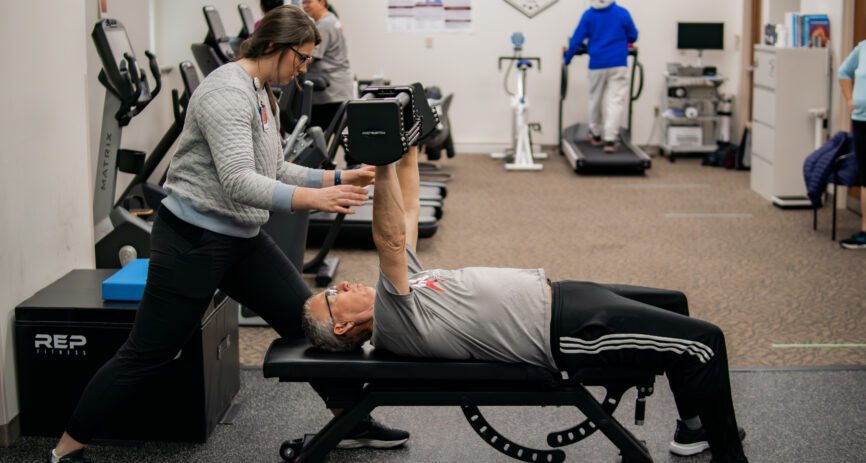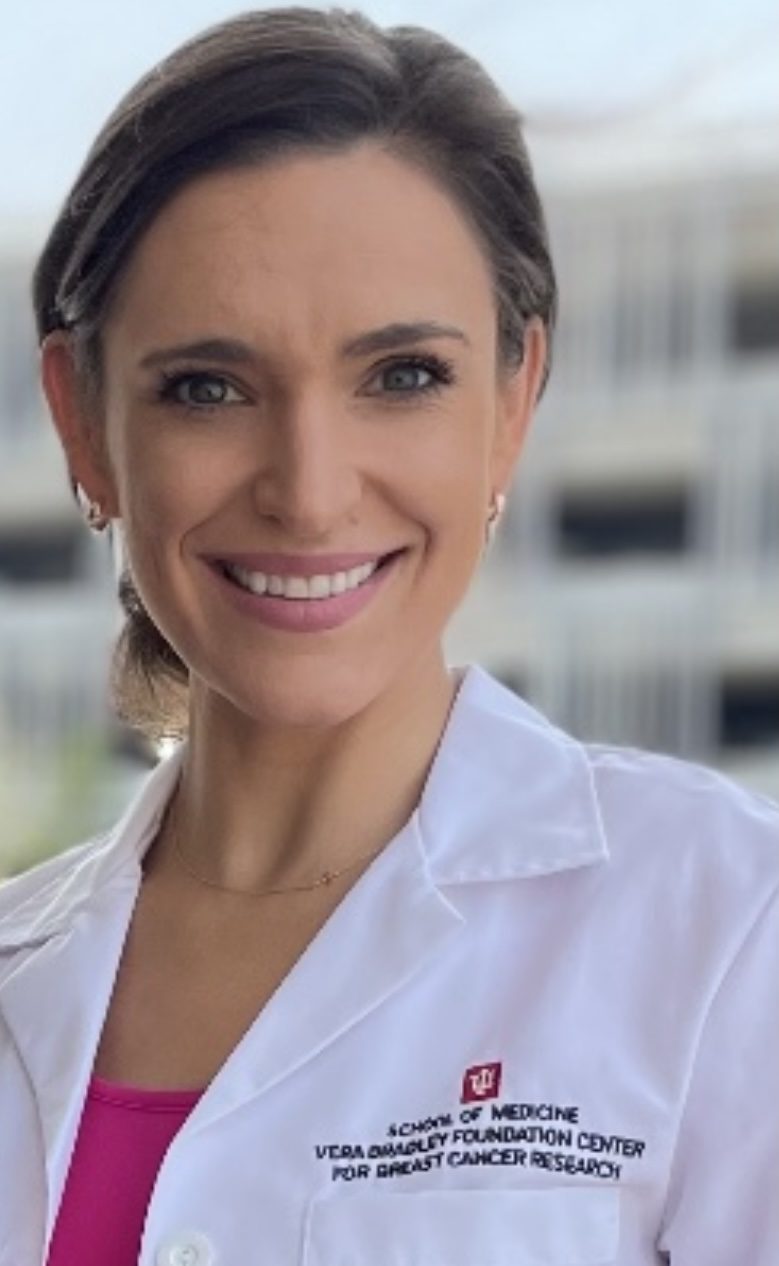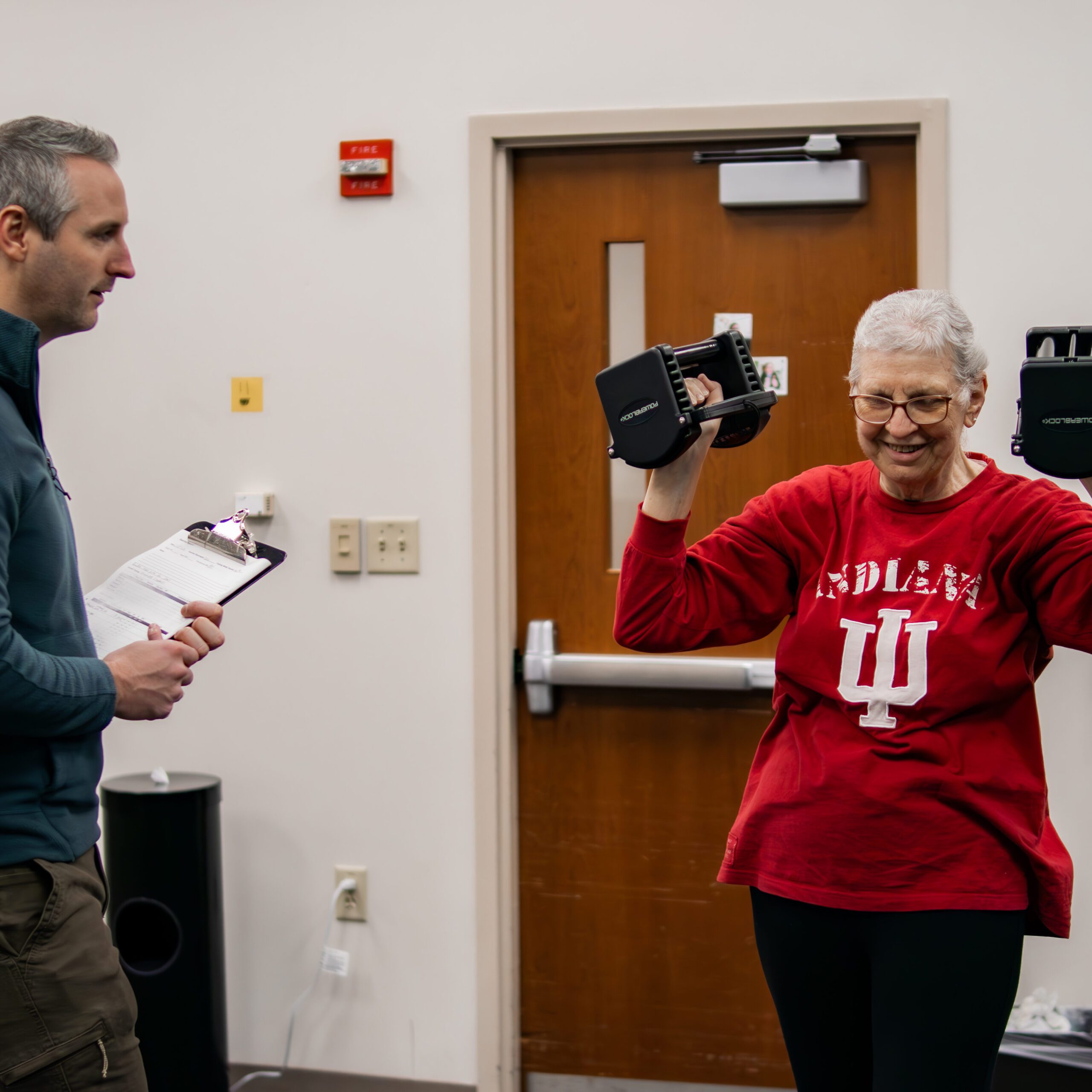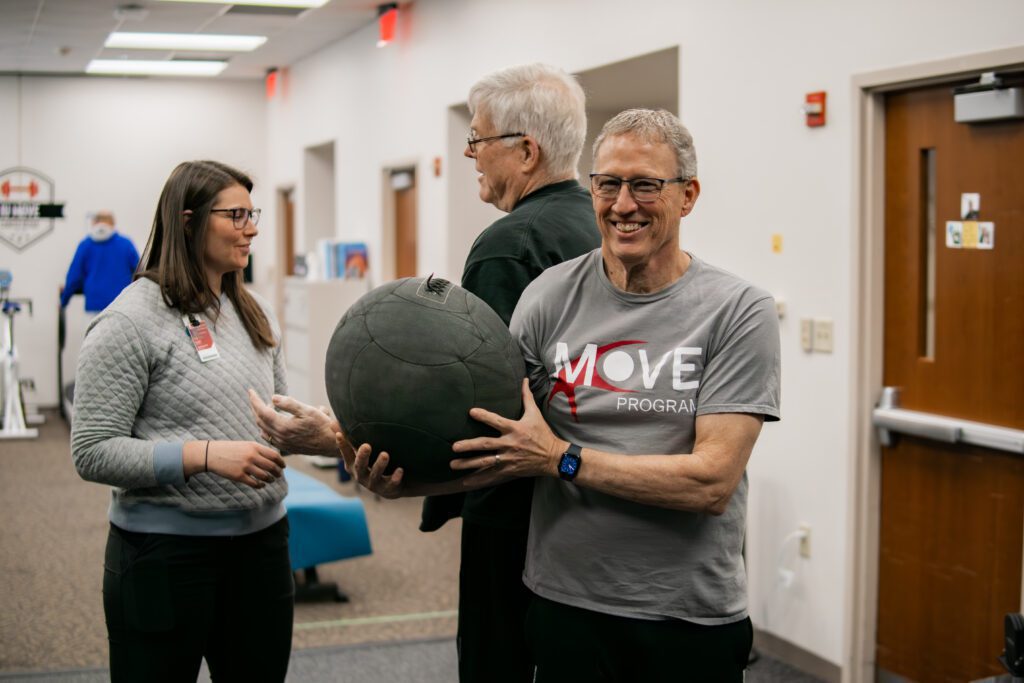
Q & A: How does exercise benefit cancer patients?
Did you know exercising while going through cancer treatment can improve fatigue, fitness, strength and quality of life? Follow along as we speak to Dr. Tarah Ballinger, an oncologist and developer of the MOVE program at Indiana University, aimed at empowering patients through physical activity.
What is the MOVE program and how was it established?
The MOVE – or Multidisciplinary Oncology Vitality and Exercise – program at the IU Simon Comprehensive Cancer Center aims to integrate exercise and rehabilitation therapy into the comprehensive care for people experiencing cancer. The MOVE program was established as a grass-roots effort by myself and Danielle Halsey, an exercise physiologist, after seeing and participating in continuing research supporting the benefits of exercise for cancer outcomes. This is something patients ask about and patients need, so we saw that need and made it happen. We initially started in an empty conference room with a couple of motivated women and have grown substantially since then. Part of that growth includes our expanded research focus as we’ve been able to establish a research team to help identify eligible patients and engage them in supportive oncology research, which focuses on lifestyle medicine, quality of life, and symptom control.

What are some of the major benefits of the MOVE program for patients?
The MOVE program is personalized, so the benefits vary depending on the patient, their needs, and where they are in their cancer journey. In general, major benefits include improved fitness, less cancer-related fatigue, improved functional status to allow patients to get back to activities they enjoy faster, and better tolerability of cancer therapy. Exercise through the MOVE program can also help with other side effects of cancer including depression, pain, or neuropathy (nerve pain), among others.
In your view, what is the biggest impact the MOVE program has had on your patients’ lives?
To me, the biggest impact is something we can’t really measure, and that is the feeling of empowerment. Many patients think they can’t do this, but they can and just need some help. The feeling of doing something you didn’t think you could, and the feeling of taking back some control from what cancer has done to you, is immeasurable and so important.
In previous discussions, you highlighted the importance of patients being proactive in their health, and the MOVE program plays a role in enhancing both physical and mental well-being. What additional proactive financial considerations should patients anticipate that may differ from standard clinical treatments? For instance, expenses related to transportation to program locations, gym memberships, or acquiring special gear/equipment for home care.
Through support from foundations like HOPE, we are able to offer MOVE program free of charge to patients. This includes training sessions, gym access, equipment such as resistance bands for home, and parking passes. Transportation can be difficult for some patients, and to combat this, we offer virtual exercise sessions as well. In 2024, we plan to start offering group classes to expand our hours into the evening and hope to build more partnerships at other locations throughout the central Indiana area.
In your experience, how can patients become advocates for their own health within the healthcare system, particularly when dealing with a complex condition like breast cancer?
Information is power when dealing with a cancer diagnosis. Bring a support person to your visits, and if you don’t have one, ask the healthcare system to help you with a patient advocate or support group member. Take notes. Write down all of your questions between visits and do not be afraid to ask them. Ask what other support services, such as the MOVE program, might exist that would help you that you haven’t been offered.

What are some of the most important data points currently highlighting how exercise helps cancer patients?
Recently, the American Society of Clinical Oncology (ASCO), the world’s leading organization for cancer care, released a guideline recommending that all patients have exercise therapy as part of their cancer care. This is based on data showing that exercise improves fatigue, fitness, strength, and quality of life. Decreased physical function and lack of physical activity are associated with reduced response to treatment and worse survival in some types of cancers. For example, in early-stage breast cancer, higher levels of physical activity are associated with a 31% reduction in deaths from breast cancer and a 48% reduction in deaths overall.[1] Even beyond an impact on survival, physical activity or exercise and addressing physical function can prevent or improve several cancer-related physical and psychological morbidities. Evidence exists for improvements in pain, fatigue, mobility issues, nerve pain, weight gain, brain fog, and depression/anxiety, among others. Much of this work has been done in early-stage cancers. In the MOVE program, we are currently studying the role of exercise in patients with metastatic breast and lung cancers. We are delivering remote 1:1 exercise therapy with the hopes of improving fitness and function, as well as biomarkers that predict progression of cancer.
Besides prescribed Physical Therapy, what do you suggest cancer patients do at home for supplemental exercise?
This depends on many factors including cancer diagnosis, treatment, age, other medical problems, etc. However, in general, any movement that increases your heart rate is beneficial. For some patients, that might be going for a fast-paced walk for a few miles. For others, that might just be walking up and down the hallway a few times. Be aware and intentional about movement. Strength training is also important and this can be done in the home with resistance bands or just body weight. Several resources exist for strength training and I recommend advocating for yourself to get some instruction on a good program you can carry on independently at home. Also, get family or friends involved for accountability and for the improved general health of everyone.
Have you noticed any challenges patients face when joining the MOVE program?

The larger challenge is overcoming the barrier of thinking it won’t be helpful, or the idea that “what will be, will be” and that you can’t do anything to change the situation. Patients who have never exercised before are intimidated or nervous, so getting to that first appointment is the hardest part. We are working on ways we can improve patient education, motivation and self-efficacy to get them in the door for Day 1.
What prioritized actions could a newly diagnosed patient take to prepare for lifestyle changes that come along with a cancer diagnosis and correlating treatments?
A good starting point is to outline your goals. What things do you hope to be able to do despite cancer? What are you fighting for? Write this down and look at it as you go through treatment, and use it to motivate you to prioritize your health. Identify your support team and think about the ways you feel supported and what you need help with. Errands? Transportation? Someone to talk to? Something to take your mind off it?
For those who have completed treatment, what can patients expect in terms of long-term survivorship, and how can they actively participate in maintaining their health?
After treatment, follow up looks different for everyone. Many patients can feel nervous about having less appointments with their team than they did during treatment. You may find you have a fear of the cancer returning, or that you never processed what you were going through and it is hitting you now. I encourage everyone to recognize these feelings are okay and normal, and to actively seek out mental health support. Exercise can also be part of that.
After cancer treatment, patients are often at higher risk for things like cardiovascular disease, so it is important to continue regular health screenings and lifestyle changes with diet and exercise that improve overall health.
A Note About HOPE
HOPE (Health Opportunity through Partnership in Education) is a non-profit organization dedicated to promoting good health, encouraging scientific research and sharing information about the prevention, detection and treatment of cancer and other serious diseases.
We’re Here to Help!
In partnership with initiatives like the MOVE program, we can better inform individuals on how to advocate for their health. Whether you are facing cancer or another critical illness, preparation and education can make all the difference. Ask about programs like MOVE and consider proactive supplemental policies to help support your physical, emotional and financial wellbeing for your future.
[1] Lahart et al, Acta Oncol. 2015.
